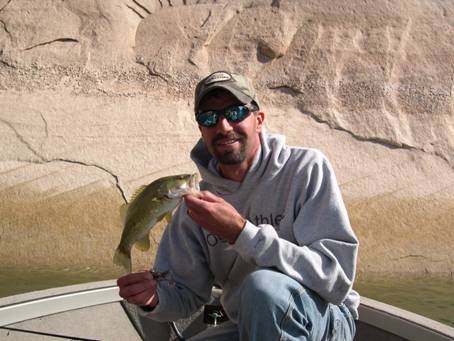|
|||
|
|
Lake Powell On The Rise; Stripers Easy Targets Lake Powell continues to rise a foot per week. The fill rate will increase when warm weather finally releases the snow pack in the mountains. There has been one cold front per week for what seems like forever. Warming and cooling have fragmented bass spawning. Some spawned early and some late, but the big event was a no show in 2008. The positive aspect of the blustery weather is that striped bass are still holding in the main channel in large numbers. They have their noses turned into the slight current, waiting for warming to trigger spawning. While there, they are easy targets for bait anglers. Graph along the edge of the channel at first light in the morning. When a school is found, a bit of chum will ignite the school into a morning feeding frenzy. Most fish will be between 1-3 pounds but fishing is intense for the first hour of the day. When the sun hits the water, fishing changes to spurts of activity followed by slow periods. The school can take off feeding again anytime. If a good spot was found in the morning, expect fish to return there during the day. It helps to have a few spots in mind to keep trying during the day to maximize the catch. Just a slight ledge or small rock slide may be enough to hold a large school of stripers. While stripers are still being caught at the dam, it seems more fish are found from Buoy 1 to the mouth of Antelope, from the power plant intake to Buoy 9, and in Navajo Canyon. Further uplake stripers are next caught at the mouth of Last Chance and then uplake to Lake Canyon, mouth of Halls Creek and Moki Canyon. I am sure there are many more spots just as good. Look at the features characterizing a historically good fishing spot and try similar areas in other parts of the lake to find your own private fishing hole. Runoff has muddied the water down to Good Hope Bay in the Colorado and to Neskahi Bay in the San Juan. The backs of canyons are still fishable, but avoid the main channel farther upstream in both arms of the lake. Smallmouth bass become active with warming water. Afternoon fishing is best after the lake has a chance to warm 3-5 degrees. If the temperature is 60 in the morning, expect bass to bite well when it reaches 65 degrees. Bass are found midway back in the canyons. In slick rock canyons, expect bass to be on relatively scarce broken rock, ledges or around brush. Always look for fish around color changes from brown to green and green to clear. Factors that cause color changes also congregate fish in select locations. At press time, lake elevation was 3,598, and water temperature: 59-66F. |
|
|
 June 2008
June 2008